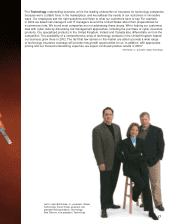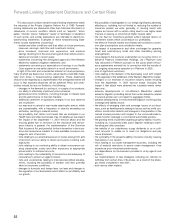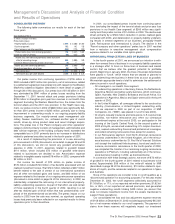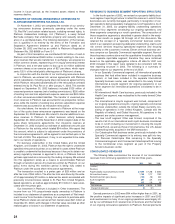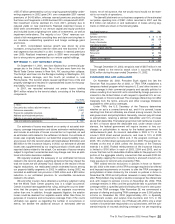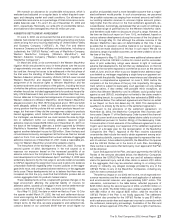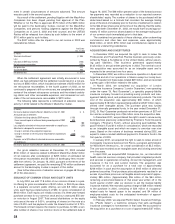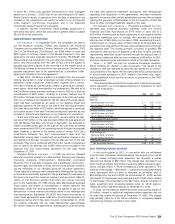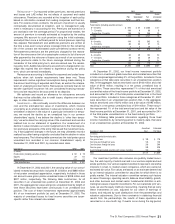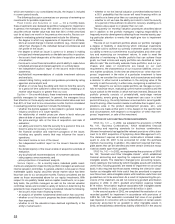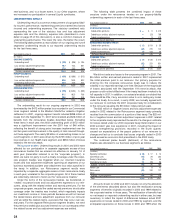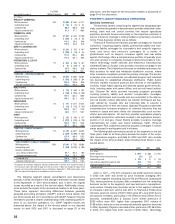Travelers 2002 Annual Report Download - page 28
Download and view the complete annual report
Please find page 28 of the 2002 Travelers annual report below. You can navigate through the pages in the report by either clicking on the pages listed below, or by using the keyword search tool below to find specific information within the annual report.
within the notice period. We have filed our proposed TRIA coverage
forms and rates, which we determined on the basis of our internal risk
modeling techniques, with state insurance regulators. Under TRIA,
these rates are immediately effective in 2003, subject to subsequent
state review.
We believe it is too early to determine TRIA’s impact on the insur-
ance industry generally or on us. Our domestic insurance subsidiaries
are subject to TRIA and, in the event of a terrorist act covered by
TRIA, the deductible alone (i.e., without consideration of the 10%
retention above the deductible) which we would be required to bear in
2003 would be approximately $460 million (based on an estimated
$1 billion event to us); accordingly, TRIA’s federal reimbursement pro-
visions alone do not protect us from losses from foreign terrorist acts
that could be material to our results of operations or financial condi-
tion. Furthermore, there is substantial uncertainty in determining the
appropriate rates for offering TRIA coverage (and coverage for terror-
ist acts generally), and our quoted rates could be too low and attract
poor risks or, alternatively, could be higher than our competitors and
result in the loss of business. There are numerous interpretive issues
in connection with TRIA’s implementation by the Secretary of the
Treasury that remain to be resolved, including the timing of federal
reimbursement for TRIA losses, the standards for obtaining the fed-
eral reimbursement, the mechanisms for allocating losses exceeding
insurers’ deductibles and the participation by captive insurers in TRIA
coverages. We currently have property reinsurance that would cover
only a portion of our deductible. Our current coverage expires in April
2003, and there can be no assurance that coverage can or will be
replaced. Additionally, there can be no assurance TRIA will achieve its
objective of creating a viable private insurance market for terrorism
coverage prior to TRIA’s expiration, and rates and forms used by us
and our competitors may vary widely in the future.
Regardless of TRIA, some state insurance regulators do not per-
mit terrorism exclusions in various coverages we write, and currently,
we have not excluded coverage for terrorist acts by domestic terror-
ists (e.g., the Oklahoma bombing) in our domestic coverages, or
resulting from terrorist acts occurring outside the United States from
our international coverages. Accordingly, our exposure to losses from
terrorist acts is not limited to TRIA coverages. Losses from terrorists’
acts, whether arising under TRIA coverages or otherwise, could be
material to our results of operations and financial condition.
PURCHASE OF TERRORISM COVERAGE AND EXPOSURE TO
FUTURE TERRORIST EVENTS
After the terrorist attacks in September 2001, reinsurers, in gen-
eral, specifically excluded terrorism coverage from property reinsur-
ance treaties that subsequently renewed. As a result, in the second
quarter of 2002, we purchased limited specific terrorism coverage in
the form of two separate property reinsurance treaties — a per-risk
terrorism treaty and a catastrophe terrorism treaty. The per-risk treaty
provides coverage on a per-building, per-event basis for a loss of up
to $110 million, after a first layer of $15 million of losses retained by
us. The catastrophe terrorism treaty provides coverage of up to
$200 million in excess of the first $100 million of losses resulting from
catastrophic losses caused by terrorism. Both treaties have one addi-
tional set of limits for subsequent terrorism events and expire in April
2003. In addition, we have renewed the majority of our reinsurance
treaties covering workers’ compensation and general liability busi-
ness. Thus far, those renewals included coverage for terrorism. Our
reinsurance treaties do not cover acts of terrorism involving nuclear,
biological or chemical events.There can be no assurance that we will
be able to secure terrorism reinsurance coverage after the expiration
of our current treaties in April 2003.
NATURAL CATASTROPHE RISK MANAGEMENT
Our property-liability insurance operations expose us to claims
arising out of natural catastrophes, as well as terrorism. Natural catas-
trophes can be caused by various events, but losses are principally
driven by hurricanes and earthquakes. The incidence and severity of
natural catastrophes are inherently unpredictable and may materially
26
reduce our profitability in a given period or even harm our financial
condition.The extent of losses from a catastrophe is a function of both
the total amount of insured exposure in the affected area and the
severity of the event.
Most catastrophes are restricted to small geographic areas; how-
ever, hurricanes and earthquakes may produce significant damage,
especially in areas that are heavily populated. Most of the catastro-
phe-related claims in our ongoing businesses in the past five years
have related to commercial property coverages in the United States.
The geographic distribution of our business subjects us to natural
catastrophe exposure principally from hurricanes in Florida and the
Mid-Atlantic, Northeast, and Gulf coast regions, as well as earth-
quakes in California, along the New Madrid fault line and in the Pacific
Northwest region.
We attempt to estimate the impact of certain catastrophic events
using catastrophe models developed by outside vendors. Models are
applied to evaluate our exposure to losses arising from individual con-
tracts and in the aggregate. Underwriting controls and systems exist to
insure that individual contracts conform to our risk tolerance, fit within
our existing exposure portfolio, and are priced at appropriate levels.
We rely significantly on reinsurance to limit our exposure to natu-
ral catastrophes. Reinsurance exists both at an account level and at
the portfolio level, where we purchase a specific natural catastrophe
reinsurance treaty. In the event that reinsurance capacity providing
natural catastrophe protection becomes limited, we would adjust our
direct exposures accordingly.
There can be no assurance that our underwriting risk manage-
ment procedures and our reinsurance programs will limit actual losses
to a level consistent with our risk tolerance. Losses from an individual
catastrophe, or a series of catastrophes, may materially exceed such
amount. Actual results may vary from the expectations developed in
our catastrophe modeling, and such variances could negatively
impact our reinsurers and the related reinsurance recoverables.
REINSURANCE
Purpose. When we purchase reinsurance or “cede” insurance pre-
miums and risks, other insurers or reinsurers agree to share certain
risks that we have underwritten. The primary purpose of reinsurance
is to limit a ceding insurer’s maximum net loss from individually large
or aggregate risks as well as to provide protection against catastro-
phes. Our reinsurance program is generally managed from a corpo-
rate risk-tolerance perspective. Reinsurance contracts addressing
specific business center risks are utilized on a limited basis to cover
unique exposures as necessary. Our reinsurance program addresses
risk through a combination of per-risk reinsurance and reinsurance
contracts protecting against the aggregation of risk exposures.
Facultative reinsurance, which covers specific risks, is also used to
supplement our reinsurance program. Until the transfer of our ongo-
ing reinsurance operations to Platinum in November 2002, we under-
wrote assumed reinsurance coverages on a worldwide basis.
In the wake of the terrorist attack in 2001, price increases and
pressures on contract terms and conditions continue in the reinsur-
ance market.Despite these constraints, our reinsurance program con-
tinues to support our primary underwriting reinsurance needs,
particularly as increases in rates and reductions in limits also continue
in the reinsurance market.
Creditworthiness of Reinsurers.Approximately 98% of our domes-
tic reinsurance recoverable balances at December 31, 2002 were with
reinsurance companies having financial strength ratings of A- or
higher by A.M. Best or Standard & Poors, were from state sponsored
facilities or reinsurance pools, or were collateralized reinsurance pro-
grams associated with certain of our insurance operations. We have
an internal credit security committee, which uses a comprehensive
credit risk review process in selecting our reinsurers. This process
considers such factors as ratings by major ratings agencies, financial
condition, parental support, operating practices, and market news and
developments. The credit security committee convenes quarterly to
evaluate these factors and take action on our approved list of reinsur-
ers, as necessary.



